A rice cake is any food item made from rice that’s been condensed, shaped, and combined into a single object. A wide variety of rice cakes exist. For example, the puffed rice variety is the most common in the US, while sticky rice cakes are common in Asia. We’ll be covering all types of rice cakes in this article.
Are they vegan? The basic ingredients for rice cakes (all types) are 100% vegan, but the food products do come in numerous varieties and flavors, many of which call for animal-derived ingredients.
What we’ll do here, is cover the different types of rice cakes, and specific challenges each type may pose for vegans.
The Vegan Status of Puffed Rice Cakes
Puffed rice cakes are generally synonymous with rice cakes in the US. This type of rice cake is a hard, flat food made with puffed rice. It’s typically eaten as a healthy snack—though, not all would be considered healthy, depending on the sodium content and whether white vs. brown rice was used.
They’re made with puffed rice, which is a puffed grain usually produced by heating rice kernels with steam under high pressure—though other methods can be used—at which point, the puffed grains are bound together using a wide variety of methods to form a cake.
If you like plain rice cakes, you’re in luck, because most merely contain rice and salt. For vegans, problems tend to come with the various flavors on offer. For example, common non-vegan flavors include chicken (though this flavor can be vegan oddly enough), butter, cheese, chocolate, and caramel.
Non-Vegan Ingredients in Puffed Rice Cakes
Chocolate
Chocolate is often a problem because milk derivatives can be used.
For example, Quaker Chocolate Rice Cakes include milk chocolate chips which contain sugar, chocolate liquor, dry whole milk, cocoa butter, soy lecithin, and vanillin.1
Caramel
As you’ll see below, not all caramel-flavored rice cakes are non-vegan. But, if actual caramel is used, it would render the product unsuitable for vegans, because lactose tends to be used for the browning reaction in caramel production.
Butter
Like caramel, not all butter-flavored food products contain actual butter. You’ll have to scan the allergy section of the ingredients to see if milk products are used.
Artificial butter flavoring usually contains acetyl propionyl, diacetyl, or acetoin, which are three compounds naturally present in butter (contributing to its characteristic flavor) but can be derived outside of using actual butter—i.e. via microbial fermentation.2
Manufacturers prefer these compounds because they’re not milk-derived, and thus needn’t be listed in the allergy section.
However, some products do use actual butter to derive the flavorings.
For example, Quaker Butter Popcorn Rice Cakes contains whole grain brown rice, degerminated milled corn, salt, and natural flavor. It may not be immediately apparent where the flavor comes from, but if you look further down on the label you’ll see “contains milk.”3
Cheese
This is a common flavor. Unlike butter, most cheese-flavored food products tend to use non-vegan ingredients.
For example, Quaker White Cheddar Rice Cakes contain the usual rice cake ingredients along with nonfat milk, buttermilk, cheddar cheese (cultured milk, salt, and enzymes), butter (cream and salt), whey, buttermilk fat, and even egg.4
Other Milk Derivatives
Milk comes in many forms. For example, Quaker Tomato Basil is a surprisingly non-vegan flavor. It contains lactose.5
Lactose is the simple sugar in milk and tends to be used to impart a nice tangy flavor.
Commercial Vegan Puffed Rice Cakes
QUAKER Lightly Salted Rice Cakes
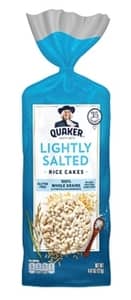
These contain only whole grain brown rice and salt, so they’re perfectly suitable for vegans and are on the healthier side, compared to other rice cakes.6
QUAKER Salt-Free Rice Cakes
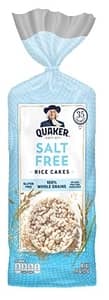
These contain the whole grain brown rice minus the salt.7
I suppose the binder comes from the natural sticky consistency of the rice.
QUAKER Caramel Corn Rice Cakes
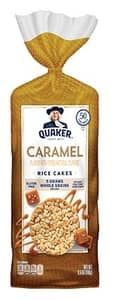
These contain whole grain brown rice, degerminated milled corn, sugar, fructose, maltodextrin, caramel color, natural flavor, salt, and soy lecithin.8
If the caramel color caught your eye, you needn’t worry. Caramel color is not derived from actual caramel. The same browning reaction is performed to produce the substance from which the color is extracted. But, the reaction is done with simple sugars like glucose—instead of lactose as in real caramel.
Specifically, caramel color is made by heating simple carbs like fructose, sucrose, dextrose, molasses, invert sugar, and starch hydrolysates, usually in the presence of salts, acids or alkalis.9
QUAKER Apple Cinnamon Rice Cakes
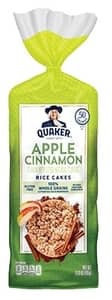
These contain whole grain brown rice, sugar, fructose, and maltodextrin, along with natural flavor, cinnamon, and soy lecithin.10
Dark Chocolate Rice Cakes by Element
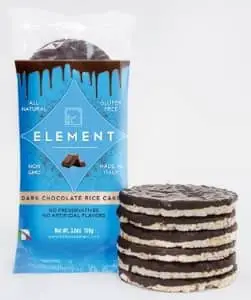
These appear to be marketed to vegans and contain 60% dark chocolate (non-bone char sugar, cocoa mass, cocoa butter, soy lecithin, and natural vanilla flavor), and rice cakes (whole grain brown rice using non-GMO rice).11
These don’t have chocolate flavoring througout the rice cake, but instead, have a coating of real chocolate on one side of a plain rice cake.
The Vegan Status of Other Rice Cakes
The term “rice cake” can also be used to refer to mounds or cakes made from wet or sticky rice—as opposed to the dry, crunchy variety covered above. This type of rice cake tends to be vegan because the specific type of rice used is glutinous rice, which provides its own binder.
Now, it can be served with non-vegan ingredients or in entrees that contain animal products, but the rice cakes themselves are perfectly suitable for vegans.
Glutinous rice is slightly sweeter, stickier, and a bit more translucent when heated compared to regular white rice. Because of its sticky consistency, it can be shaped and molded for use in rice cakes as well as rice dumplings, and sushi.12
It’s mainly grown in Southeast and East Asia and certain parts of South Asia.13
It differs from other rice in that it has opaque grains, a very low amylose content, and high amounts of amylopectin, making it extra sticky when cooked.14,15
Keep in mind it’s called glutinous, due to its glue-like or sticky, and not because it contains gluten (which it doesn’t).16
Suman is a popular form of rice cake that originated in the Philippines. It’s made from glutinous rice cooked in a medium of coconut milk. It’s often wrapped in buli or buri palm leaves or banana leaves for steaming.
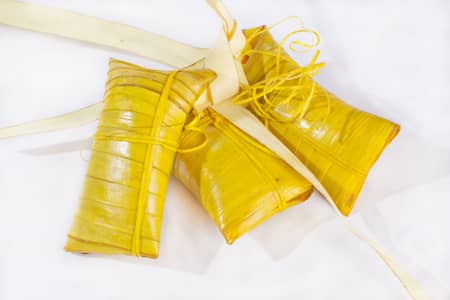
Because it’s made with coconut milk, instead of real milk, it tends to be vegan-friendly.
Again, it’s important to note that, while the rice cakes themselves are usually vegan, they’re often served with non-vegan foods. Sushi is a good example. Sushi, a popular food originating in Japan, is raw fish. So, while it’s suitable for pescatarians, rice cakes served with sushi would be unsuitable for vegans.
Similarly, the combination of tuna with rice cakes is a popular dish. While there may be vegan tuna alternatives on the market, actual tuna is never suitable for vegans.
Anyway, that wraps it up for rice cakes. Thanks for reading.
You may also want to check out the following related articles:
- Are Rice Krispies Vegan? It Depends
- Is Pita Bread Vegan? What About Pita Chips?
- Are English Muffins Vegan?
- Are Bagels Really Vegan? The Bottom Line
- Is Couscous Vegan?
- Is Quinoa Vegan?
References
- Chocolate. Pepsi – https://www.quakeroats.com/products/rice-snacks/rice-cakes/chocolate
- Siegel, H.; Eggersdorfer, M., “Ketones”, Ullmann’s Encyclopedia of Industrial Chemistry, Weinheim: Wiley-VCH.
- Butter Popcorn. https://www.quakeroats.com/products/rice-snacks/rice-cakes/butter-popcorn
- Quaker Rice Cakes, White Cheddar, 5.5 Oz Bag Mitchell – https://www.walmart.com/ip/Quaker-Rice-Cakes-White-Cheddar-5-5-oz-Bag/10312600
- Tomato and Basil. https://www.quakeroats.com/products/rice-snacks/rice-cakes/tomato-and-basil
- Lightly Salted. Pepsi – https://www.quakeroats.com/products/rice-snacks/rice-cakes/lightly-salted
- Salt-Free. Pepsi – https://www.quakeroats.com/products/rice-snacks/rice-cakes/salt-free
- Caramel Corn. Pepsi – https://www.quakeroats.com/products/rice-snacks/rice-cakes/caramel-corn
- Caramel Color. https://en.wikipedia.org/wiki/Caramel_color#Production
- Apple Cinnamon. https://www.quakeroats.com/products/rice-snacks/rice-cakes/apple-cinnamon
- Dark Chocolate Rice Cakes By Element. Anonymous – https://store.veganessentials.com/dark-chocolate-rice-cakes-by-element-p4259.aspx
- Understanding Food: Principles and Preparation (Page 351). Amy Brown – Wadsworth Cengage Learning – 2011
- Glutinous Rice. https://en.wikipedia.org/wiki/Glutinous_rice
- “NC State Geneticists Study Origin, Evolution of “Sticky” Rice” (Press release). 21 October 2002. Archived from the original on 13 September 2006. https://web.archive.org/web/20060913081510/http://www.ncsu.edu/news/press_releases/02_10/275.htm
- Kenneth M. Olsen and Michael D. Purugganan (1 October 2002). “Molecular evidence on the origin and evolution of glutinous rice”. Genetics. 162 (2): 941–950. PMC 1462305. https://www.ncbi.nlm.nih.gov/pubmed/12399401
- Oxford English Dictionary. glutinous, a. SECOND EDITION 1989.


